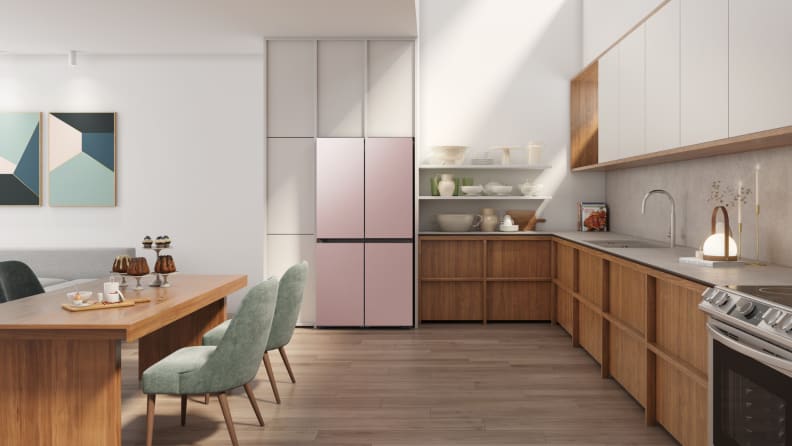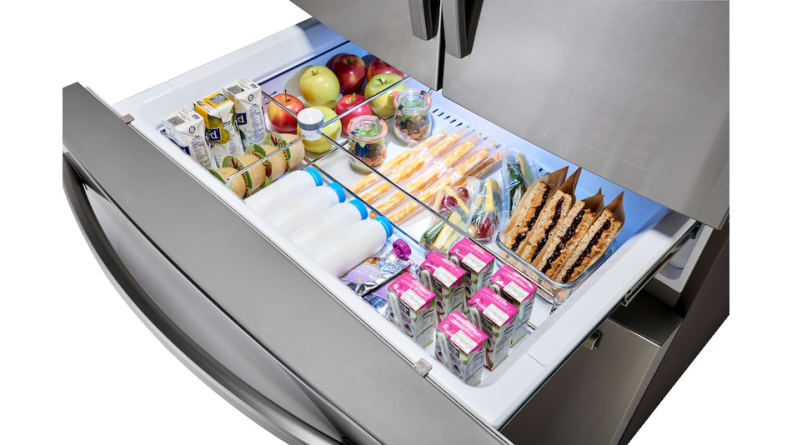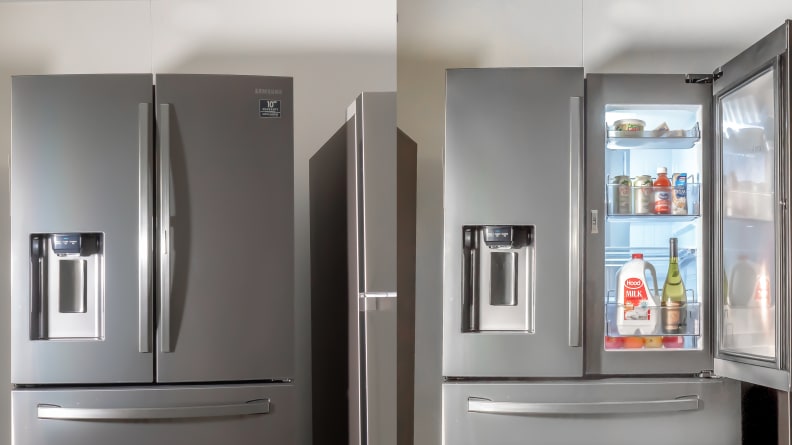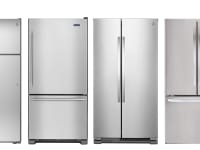8 refrigerator features that work smarter not harder
From speedy ice makers to smudge-proof finishes
 Credit:
Bosch
Credit:
Bosch
Recommendations are independently chosen by Reviewed's editors. Purchases made through the links below may earn us and our publishing partners a commission. Prices were accurate at the time this article was published but may change over time.
Buying a new fridge can be a daunting task—especially if you're a first-time buyer or haven't shopped around in a while. Over the past decade, refrigerator features, styles, and other options that are part of this integral kitchen appliance have skyrocketed, both in sheer number and in quality.
Modern fridges are loaded with extras, some of which are unique to certain styles (top freezer, bottom freezer, French door, side-by-side, or column). While new refrigerator features each have their own niche usefulness, they also tend to jack up the price, which means you'll end up paying more and getting less.
This being said, many newer refrigerator features bring some incredible functionality to fridges that you may not be familiar with—so let's explore what's out there.
1. Smudge-proof finishes, clean lines, and colorful cross-appliance designs

Samsung
White and stainless steel fridges are the most classic fridge finishes, but even these traditional looks have been refined more recently.
Newer fridges almost exclusively have fingerprint-resistant finishes, which is an absolutely indispensable innovation for anyone who's ever owned a glossy-finished fridge and had to polish away fingerprints on a daily basis (read: parents). These newer finishes barely show any fingerprints or smudging at all.
Aside from this, several refrigerator brands offer appliances with finishes that are coordinated across products. For example, Samsung's Bespoke lines have matching looks for everything, from major appliances, like fridges and ovens, to smaller items, like digital assistants and speakers.
There's a lot of options out there for consumers who want to customize their fridge's facade, from black stainless and matte finishes to all different combinations of metals.
Recessed handles, as seen on the Bosch's 800 series, are another design choice making its way onto fridge doors. Recessed handles help provide a more seamless look, and are a great alternative for anyone who doesn't want a protruding handle.
Ideal customer: Parents and pet owners, design-minded consumers
2. Ice-makers built for speed, volume, or craft

Spherical ice doesn't just look good—its low surface area means it'll melt slower and dilute drinks less.
Many modern fridges now also come with built-in ice-makers and filtered water dispensers.
There are two kinds of dispensers, internal and through-the-door. Internal dispensers typically keep a filtered water dispenser in the fridge compartment, with an ice-maker and reservoir in the freezer. A through-the-door dispenser is available for use from outside the fridge, allowing you to fill up on ice and water without having to open a door.
Many dispensers are lacking when it comes to ice—especially through-the-door designs, which typically have much smaller reservoirs.
Two companies that have stepped up their ice game, however, are LG and Bosch, though both take completely different approaches.
Bosch is going for speed and consistency with their QuickIcePro system, which is capable of producing 40 glasses worth of ice (about 12 pounds) every day. Now, this seems like a lot, so when we got the B36CD50SNS into our labs, we tested this feature—and it delivered. If you're a perpetual host and want a fridge that can keep up with your guests, Bosch is at the front of the pack.
LG takes a lot more time to produce ice, but it's doing so in a more specialized ice. For example, the new LG LRMVS3006S can produce spherical ice cubes. Not only do these ice cubes just look aesthetically pleasing—think craft cocktails—they're also surprisingly functional: Spheres have the lowest surface-area possible, which means a spherical ice cube melts more slowly, providing even cooling over long periods of time.
This is why you'll most often see spherical ice used in cocktail bars or the glasses of connoisseurs, since you can take your time to enjoy the drink without worrying about it getting watered down.
Ideal customer: Ice-lovers, cocktail drinkers, perennial hosts
3. Smart features to help plan entire meals or let you know when the door is open
Smart refrigerators have come very far in recent years. In older reviews, just about the only smart feature we'd praise was the ability to get a push notification when the door was left ajar. Nowadays, the fridge is increasingly becoming the command center for smart homes.
We've done an in-depth look on the state of smart home platforms, but to summarize, each different platform has their own unique focus and suite of features.
LG, for example, is focused on data analytics. It collects your usage data and uses that to help you get even more out of the devices you own.
Samsung's Family Hub serves as a command center for your SmartThings interconnected home via a large touchscreen on your fridge that you can use to check your smart doorbell's video feed, order new groceries based on an automated inventory, or suggest recipes based on what you actually have in stock.
Bosch's smart platform is all about automation, leveraging the popular task-batching software IFTTT to help users create complex series of actions that will execute automatically via a customized voice command.
Ideal customer: Tech-savvy families, home automation geeks, busy people
4. Flexible storage that lets you adapt to anything

This Samsung refrigerator includes a counter-height drawer called FlexZone with temperature settings for meat/fish, cold drinks, deli/snacks, and wine/party dishes. Its moveable dividers help keep the drawer organized.
Flex drawers and flex compartments are almost exclusively found on French-door refrigerators and are one of our favorite refrigerator features.
They are typically located below the fridge compartment and above the freezer and are self-contained enclosures with their own temperature controls. You can use flex drawers to keep items at temps that are either too warm or too cold to apply to your whole fridge.
Have a bunch of left-overs and need more fridge space? Set the flex drawer's temp to match your fridge and stock up! Freezer getting a bit cramped? Turn down the temp in the flex drawer and fill it with frozen food. Want to store wine at the perfect 55°F, a temperature that would be too warm for perishables? A flex drawer will help you keep that wine perfectly chilled without spoiling everything else in your fridge.
Bosch is experimenting with a new type of flexible storage, the Flexbar. This metal bar extends across the back of the fridge, can support several different kinds of bins or shelves, and can be repositioned. This allows users to fully customize some of the empty vertical space between shelves that would otherwise go unused, without completely blocking the storage of taller items like a full shelf would.
Ideal customer: Families, hosts, wine aficionados
5. Dual evaporators to help maintain better air quality throughout your fridge
Most fridges have a single evaporator that cools both the freezer and refrigerator compartments. This means that low humidity air from your freezer gets pumped into your fridge, which creates a desiccating effect. Anyone who's accidentally stored leftovers with the lid not fully closed will know how quickly the air in your fridge can destroy food.
Unfortunately, there's issues on the other side of the equation as well: As air from your fridge recirculates to the freezer, it can bring all kinds of funky smells with it, which can seep into your frozen foods. Nobody wants their ice cream to have a slight tinge of leftover fish.
A dual evaporator fridge uses separate evaporators for both the fridge and freezer, which gets around all of these problems. Not only will your fresh veggies last longer, odors will no longer be able to cross-contaminate.
Ideal customer: Foodies
6. Better tech to help keep fruits and veggies fresher for longer
The reason crispers are often labeled as either "fruit" or "vegetables" is because it's a good idea to separate the two. As many fruits ripen, they release ethylene gas. This plant hormone can cause other fruits and vegetables to rot prematurely—one stray apple can turn a whole crisper into a veggie graveyard.
Newer Bosch fridges are aiming to solve this problem even more definitively, by integrating an ethylene gas filter into their newer fridges. Now, it doesn't matter where you're keeping your fruits and vegetables: The fridge will help remove any ethylene and keep everything in your fridge fresher for longer.
Air filtration isn't the only way newer fridges are helping leafy greens retain their crisp crunch. Beko's new Active Fresh Blue Light system, as seen on the BFTF2716SSIM, can help leaves retain their nutrients longer than they would without the light.
While we're more skeptical of Beko's claim that these lights also promote continued photosynthesis—the models we tested used lights too dim to properly achieve this goal—the science behind such a feature is sound, and we hope to see its full implementation in future iterations of the technology.
Ideal customer: Vegetarians and vegans, foodies
7. Door-in-door design and other easy access features

A door-in-door refrigerator looks like a standard French door model until you press a button on the handle and a special compartment opens. This style of fridge allows you to load your favorite foods in the door-in-door section.
A door-in-door design is one of those innovations that's difficult to appreciate until you're actually using it. How it works is one or both doors in a French-door fridge are actually split into two parts. Opening just the outside part lets you access items stored in the door bins without opening the whole door.
Now, why is this useful? Many French-door fridges require you to open both doors to access the interior of the fridge, which lets a lot of cold air escape. Furthermore, it's annoying to have to open both doors to access items stored on one or the other. This system helps create more of a barrier between the interior of the fridge and the outside, leading to less cold air loss.
It also provides much easier access to items on the door than you'd expect, as you can grab something just by cracking the door-in-door slightly, where a traditional door would need to open much further to provide the same kind of access.
Some fridges get even fancier with this idea. For example, the LG LRMVS3006S's door-in-door features an opaque black panel on the outside, which, with a knock, will turn transparent like magic. This lets you easily scope out what's on the door or the main compartment of your fridge before you even crack the door.
Ideal customer: Large families, eco-friendly consumers
8. Energy Star qualified fridges keep resource use low
If you're trying to limit your carbon footprint and want to use water and energy in your home, check a fridge's Energy Star rating to get an idea of how resource-hungry a given model is.
Some refrigerator features use a lot of extra energy, leading to a fairly wide margin. While comparing energy use might not mean much for your utility bill—fridges typically cost between $20 and $65 dollars a year, to run, with the majority falling around $40—it can help you make more energy-conscious decisions.
Every bit of energy saved matters, especially if you're planning to own this fridge for a decade or more.
Ideal customer: Eco-friendly consumers
Find a refrigerator for you
Now that we've gone over the different styles and special features that you can expect on a modern refrigerator, all that's left is picking out the right fridge for you.
Check out these lists of our top-rated fridges in different categories if you need a place to get started. We've rigorously tested them all in our in-house lab and their performances put them a cut above the rest.





